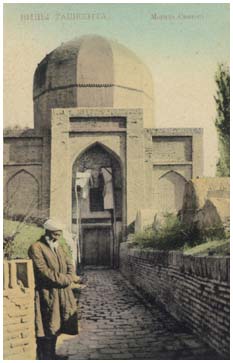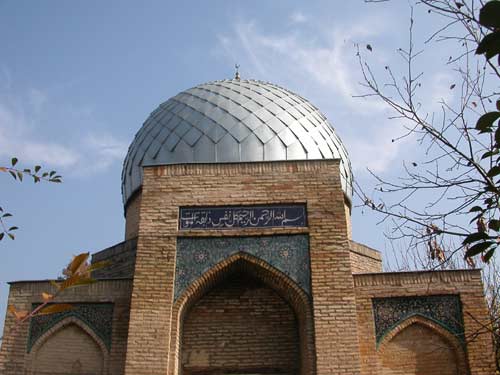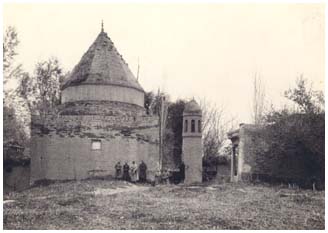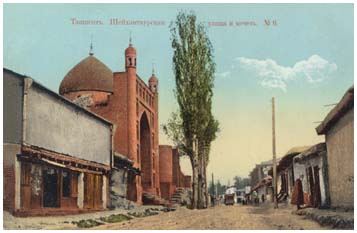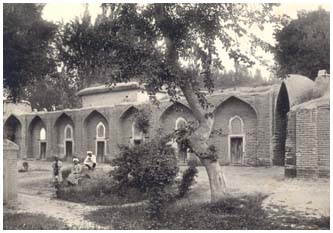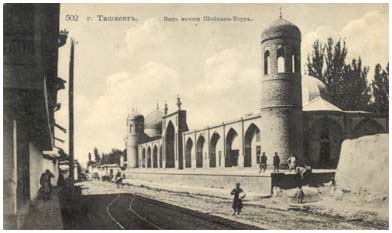Sheikhantaur - remarkable area of old city of Tashkent, which is between modern streets of Abay, A. Navoi, U. Jusupova and A. Kadyri. The front entrance of Sheikhantaur from the side of present A. Navoi Street was executed as tall square (in the plan) constructions with four big arches among which northern and southern ones were through. The lancet dome and accurate turrets - guldasta decorated this remarkable structure named "chortak". The Tashkent master usto Abd ar-Rahim, the son of usto Abdulla, have constructed Sheikhantaur chortak in 1892.
From the right side -closer to Urda along A. Navoi Street - settled down a long one-storied facade of monumental Ishankul madrasah for 34 cells. Dadha Ishankul, the son of one of deputies of Kokand khan in Tashkent, ordered to erect this building in 40th years of XIX century.
After you pass through a massive two-folding gate of chortak, covered with a skilful groove, visitor of Sheihantaur got on rather long, cobbled platform. On the left were Choyhona and big ancient Hauz Lyangar, and on the right were walls of a quarter mosque and houses of Zanjillik mahalla, named so because of the heavy iron chains suspended here which served as a protection from interfere with penetration of animals into the territory of sacred Sheihantaur.
The territory of an ancient cemetery began with the right side from Hauz at a small gate and there was large old Elm, all covered with horns of rams and goats, multi-colored trips of clothes. The tree was considered sacred, it as if contained spirit of "Kuchkar-ata", the patron of medieval shop of butchers.
Further there was the long path bordered from the western side by the whole avenue from trunks dead hardened Saurs - coniferous trees of local breed which were lifeless already in XV century. These curve trunks which are picturesquely sticking out of the ground like curve fingers of a unknown giant, national legends connected to stay on the ground of Tashkent of Alexander the Great which is very honored in the East as the ancient prophet and is called Iskandar Bicorn. The path rested against the open corridor laid out by a brick with very low walls ("hisht-yul" which through a low arch of dome-shaped ziarat-khana, built in XV century by sheikh Hodzha Ahrar, led to an entrance of main relic of Sheihantaur
Mazar Sheihantaur, repeatedly changed its shape at reorganizations, was erected here in IV century. It concludes unique, extant up to now sacred Saur of Iskander at which the gravestone of sacred is located.
Sheikh Hovendi at-Tahur (Sheihantaur) was born in the end of XIII century in the family of Hodja- descendants of Muhammad prophet in mountain settlement Bogustan (on a coast of modern Charvak impoundment). His father, sheikh Omar, was considered as the direct descendant in the seventeenth generation of the second godly caliph Omar ibn al-Hattab and was original Sufi, the follower of dervish Hasan Bulgari. Young Sheihantaur carried out a ceremony of obedience among dervishes of Jassy city (Turkestan) where already at that time there was a cult of great poet - mystic of Central Asia Ahmad Yassavi. Biographers inform, that young Tashkent dervish was especially struck by one of statements of Turkestan hazrat: "High spiritual qualities and knowledge of sciences are directly proportional to patience and mildness of Sufi in relation to roughness of ignoramuses". After long wanderings around Maverannakhr, Sheihantaur came back home, lived his life did teaching in Tashkent and remained in memory of people as wisest of the wisest. The sheikh died between 1355 and 1360. From this date the history of a majestic complex of the mausoleums and the mosques, named Sheihantaur begins.
Around of esteemed mazar still in XIV century there was a cemetery where for the next centuries there were buried many outstanding figures of the Central Asian history. It is possible to specify names of the founder of the Tashkent state in XVIII century - Sheihantaur hakim Unus Hodja, Alimkul Parvanchi - Kokand commander protecting Tashkent from armies of General M. G. Chernjaev in 1865, Head of Big Juz Rustam Muhammad Bahadur-khan who died in 1712. In Sheihantaur, there were gravestones of wife of Sheibani-khan by name Jamal Khanum (a plate of 1518) and last governor of Kokand Khanate Nasr ad-din. According to medieval annalists great poet Zain ad-din Vasifi is buried here. Unfortunately, the majority of these monuments were not extant up to now.
Two monumental buildings constructed in XV century, still can be seen today. It is mausoleum of Kaldirgach-biy with a characteristic peaked dome where ashes of the well known judge Tole-biy from Duglat clan which actually ruled Tashkent in first half of XVIII centuries, and the mausoleum of Mogolistan Unus-khan. The Mausoleum was erected in the first half of the 15th century. The yard and decoration weren't kept safe




